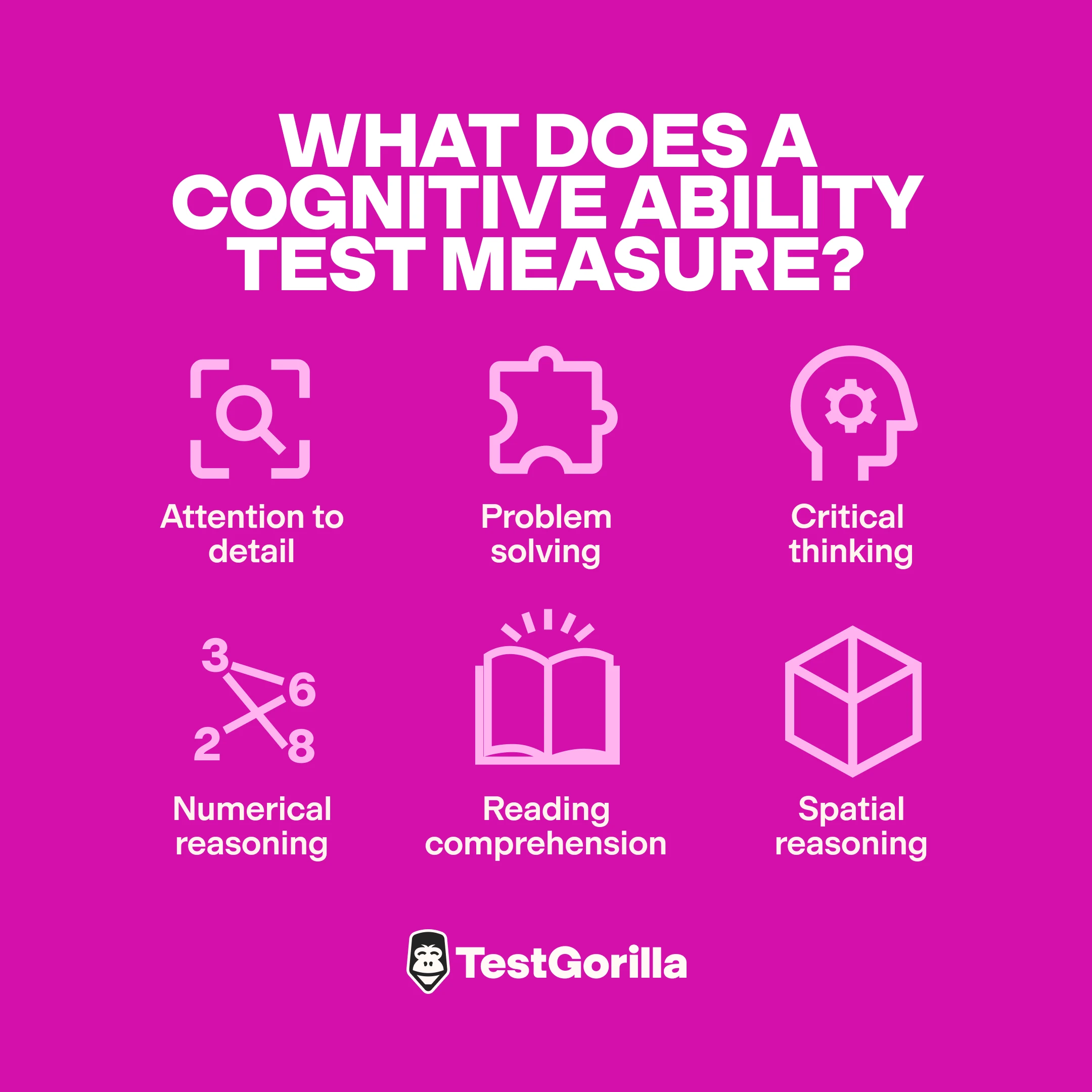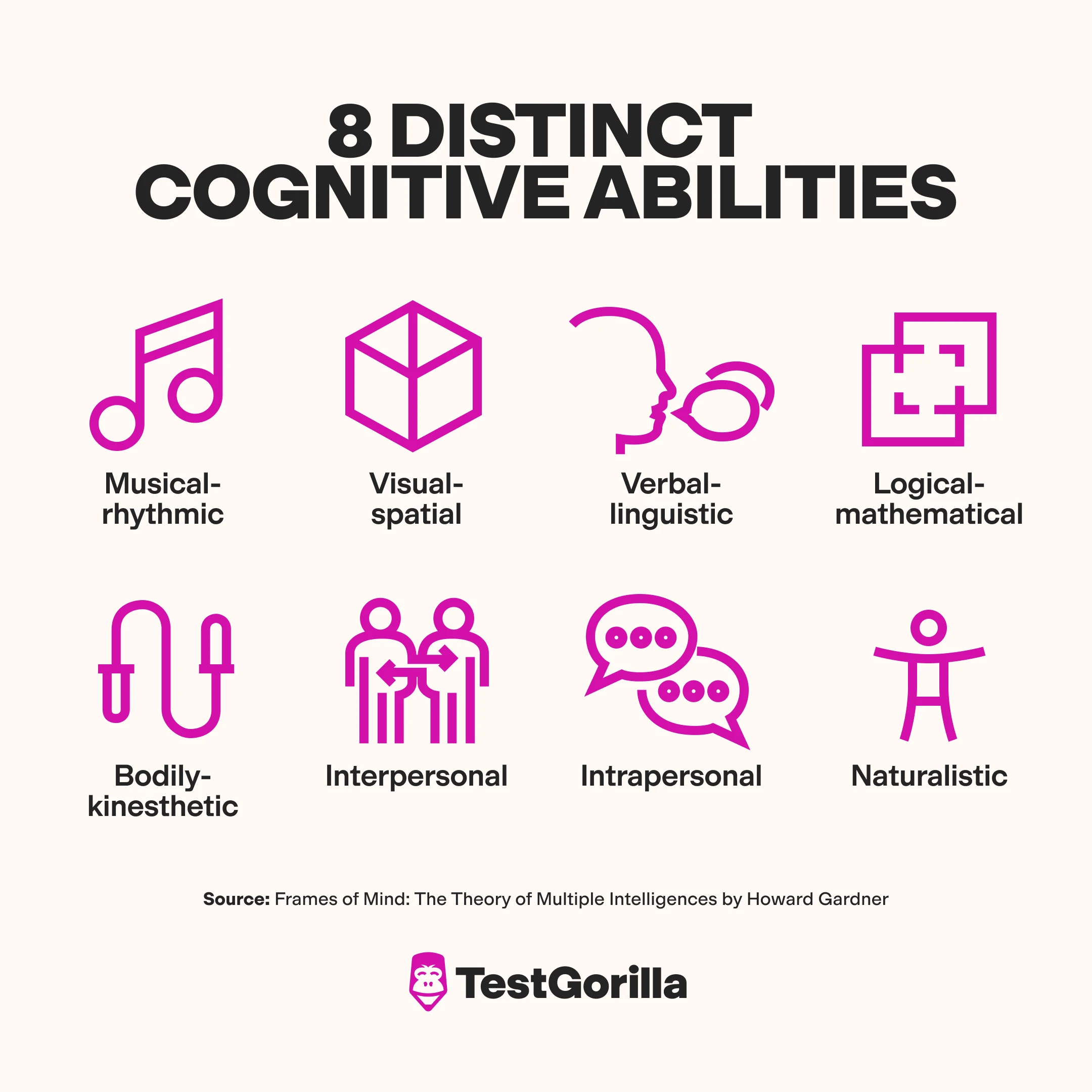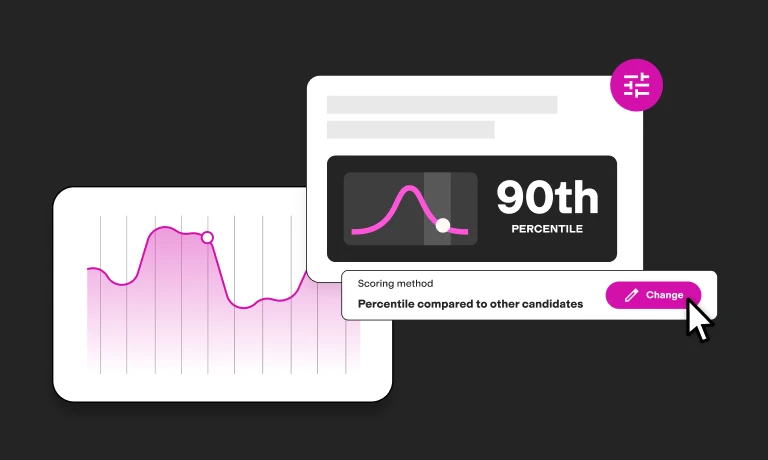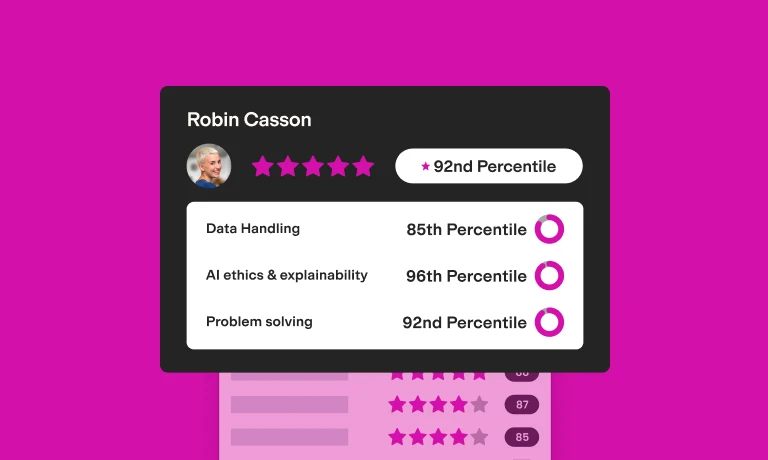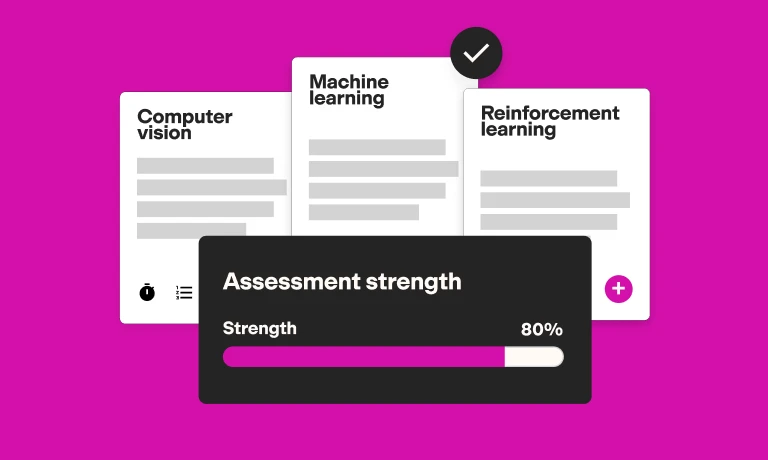Cognitive ability tests are the key to a better hiring process
Every time they advertise an open role, recruiters need to screen stacks of resumes, many of them almost exact duplicates of each other. But assessing applicants by focusing on resumes doesn’t enable recruiters to predict future job performance.
So, how can they achieve this with confidence?
Candidate screening tests offer a solution. With TestGorilla’s extensive library of over 400 tests, recruiters may feel overwhelmed when selecting the most suitable tests for their hiring needs. One potentially beneficial option is a cognitive ability test.
They can help you get answers to questions like:
Can a candidate think abstractly?
How easily can they understand complex concepts?
How quickly do they learn?
How adaptable are they to change?
This article is an introduction to using cognitive ability tests for employment. It’ll help you understand what a cognitive ability test is, what they assess, and how to choose the most appropriate type of cognitive ability test type for your hiring needs.
Table of contents
- What is a cognitive ability test?
- Should recruiters use a cognitive ability assessment for hiring?
- The benefits of cognitive ability testing
- The risks of cognitive ability testing
- Types of cognitive ability tests for employment: Why are there so many different tests?
- Types of cognitive ability tests
- A step-by-step guide to hiring using cognitive ability tests for employment
- Dos and Don’ts: Cognitive ability testing tips and best practices
- Cognitive ability testing tools & resources
- FAQ: Cognitive ability tests for employment
- Next up, read science-backed best practices for cognitive ability testing
What is a cognitive ability test?
A cognitive ability test is a pre-employment test used to measure a candidate’s cognitive skills and mental abilities, such as problem solving, spatial reasoning, and numerical reasoning. They are designed to evaluate a candidate’s mental abilities and aptitudes to predict their performance in various tasks or roles.
Cognitive ability tests come in many formats, including multiple-choice questions, logic puzzles, numerical reasoning tasks, and even games. They are widely used in recruitment for jobs, internships, and academic programs.
What does a cognitive ability test measure?
Cognitive ability tests measure a candidate’s mental abilities and aptitudes across several different categories. Through these tests, you can gain insights into a candidates’ capabilities in areas like problem-solving and numerical reasoning, helping you to understand their fit and potential.
You can use cognitive ability tests in recruitment to assess skills such as:
Attention to detail: How closely does a candidate pay attention to detail when processing new information?
Problem solving: How well does a candidate use information to make correct decisions?
Critical thinking: Is a candidate capable of thinking analytically to solve logical problems?
Numerical reasoning: How well does a candidate work with and interpret numbers?
Reading comprehension: Is a candidate able to understand the key messages in a piece of text?
Spatial reasoning: How well can a candidate understand, remember, and reason about the spatial relationships among objects or space?
How is cognitive ability tested?
Cognitive ability is typically measured through short, multiple-choice tests. Tests can consist of logic puzzles, math problems, or reading comprehension questions.
Like other types of psychometric tests used in recruitment, cognitive ability tests for employment can either focus on one individual skill (e.g. numerical reasoning) or cover almost every type of intelligence, similarly to a general intelligence test.
While the questions themselves are not overly challenging, a built-in time limit forces the candidate to think quickly. In most cases, cognitive ability tests only take 10 to 30 minutes to complete, mimicking the fast-paced nature of real-world decision-making to help you accurately predict a candidate’s workplace performance and adaptability to new situations.
At TestGorilla, we’ve broken down the core cognitive abilities into individual 9 to 13 minute tests. You can combine up to five single tests in an assessment to create a balanced mix of cognitive tests and tests of role-specific skills and use it to evaluate candidates’ skills.
Is a cognitive ability test the same as an IQ test?
Yes and no.
People often use “IQ” informally to refer to a test of someone’s general intelligence, or their ability to understand concepts and solve problems. In this loose sense, IQ tests and cognitive ability tests are similar.
That said, the technical term “IQ” (short for Intelligence Quotient) specifically indicates a score on a cognitive ability test relative to the average population in a given country, calculated as the number of standard deviations you fall away from the median test taker.
Put simply, IQ is just one way to describe the result of a specific type of cognitive ability test, which measures the test taker’s intelligence.
Examples of commonly used IQ tests include the Wechsler Adult Intelligence Scale (WAIS) and updated versions of the Stanford-Binet Intelligence Scales, Woodcock-Johnson Tests of Cognitive Abilities, and more.
However, using IQ tests for job assessment is outdated and we do not recommend using IQ tests for hiring. Instead, we advise you to use cognitive ability tests aligned with best practices for these types of tests.
Should recruiters use a cognitive ability assessment for hiring?
Should recruiters use cognitive ability tests for hiring?
There’s no ‘yes’ or ‘no’ answer to this question, unfortunately. Sure, cognitive ability tests are valuable hiring tools and can be of great use to employers. However, if not done properly, introducing cognitive ability tests into the hiring process can result in unfair disadvantages or biases toward some groups of applicants, so you may overlook excellent candidates or leave your organization open to legal risk.
Below, we outline the benefits and the risks.
The best insights on HR and recruitment, delivered to your inbox.
Biweekly updates. No spam. Unsubscribe any time.
The benefits of cognitive ability testing
Identify learning potential
Cognitive ability tests can help you spot candidates who can quickly pick up new skills and adapt to new information. They’re great for entry-level roles or for fresh grads who will go through a lot of classroom or on-the-job training. Using these tests can help to ensure your training efforts are focused on those more likely to learn, grow, and become top performers.
Holistic assessments
Multi-measure assessments are the best way to screen for multiple role-relevant skills. Performing well in a job requires multiple different skills, and cognitive ability tests can contribute by helping you measure key mental aptitudes like problem-solving and spatial reasoning. By combining these tests with others that focus on specific job skills, you can be more sure you’re evaluating all necessary skills for the role, leading to more effective hiring decisions.
The risks of cognitive ability testing
Adverse impact
Cognitive ability tests can sometimes result in adverse impact, meaning they might lead to a less diverse workforce. Generally, if there’s a valid hiring tool that poses less risk of disadvantageing certain groups, it’s better to use that tool instead. So, in some cases, it makes sense to opt for something different, like a role-specific skills test, over cognitive ability tests to ensure fairness.
Legal risk
Adverse impact in hiring can lead to legal risks. If a hiring practice disproportionately affects protected groups (e.g., under Title VII of the Civil Rights Act), and isn’t job-related, it could result in lawsuits without needing to prove intentional discrimination. If you’re using cognitive ability tests, you should regularly conduct validation studies and evaluate adverse impact. Read more about legal risk and skills-based hiring.
Types of cognitive ability tests for employment: Why are there so many different tests?
Once you’ve decided to start using cognitive ability tests, you’ll find that there are many different types. To help you make sense of all this, we’ll explore our cognitive ability test library below.
But you may be asking, why are there so many types of cognitive ability tests?
Cognitive ability tests aim to measure intelligence, but experts disagree on its definition. Despite this, most agree that intelligence is complex and can’t be captured by a single test.
Is there one general intelligence?
Early theories of intelligence proposed a single general intelligence, leading to the development of general IQ tests.
Charles Spearman, the original proponent of the General Intelligence Theory, found a strong correlation between an individual’s performance on one type of cognitive task and their performance on other cognitive tasks.
This led him to theorize that people possess a general intelligence influenced by attention, speed, memory, and visualization. He called this general intelligence “the g factor”.
Are there multiple intelligences?
But what if there is no single form of intelligence? In that case, recruiters might need to test a variety of cognitive abilities when vetting candidates.
Howard Gardner first proposed the theory of multiple intelligences in his 1983 book Frames of Mind: The Theory of Multiple Intelligences.
Drawing from studies on brain damage, evolutionary history, and a number of other factors, he theorized that intelligence should instead be broken into eight distinct cognitive abilities that are largely independent of each other.
He proposed the following eight abilities:
Musical-rhythmic
Visual-spatial
Verbal-linguistic
Logical-mathematical
Bodily-kinesthetic
Interpersonal
Intrapersonal
Naturalistic
While Gardner’s theory certainly isn’t the only accepted model of human intelligence, most modern theories include at least some form of the concept of multiple intelligences. So, it makes perfect sense that recruiters often use separate tests to evaluate different skills, including verbal skills, math skills, logic, and even creativity or emotional intelligence.
The more closely aligned the specific ability or aptitude being tested is with the core requirements of the job you’re hiring for, the better you can predict success on the job. Check out this blog post on predictor-criterion congruence for more information.
Types of cognitive ability tests
Because there are so many different facets of intelligence, there are many different cognitive ability tests to match them.
For example, the CCAT (Criteria Cognitive Aptitude Test) is popular for assessing general skills like verbal, numerical, and spatial reasoning. However, it treats all areas equally, which isn’t ideal when a role demands specific skills. That’s where TestGorilla’s alternatives to CCAT shine.
We have 15 different cognitive ability tests that evaluate candidates'skills
Basic math calculations, Intermediate math, basic triple-digit math, and basic double-digit math skills
Here’s a quick explanation of what each test measures and the roles they’re most suitable for. But keep in mind that these cognitive skills are helpful for nearly any position. We’ll also include links to examples of cognitive ability tests for employee selection.
Attention to Detail (Textual)
Attention to detail is more than just paying attention. It’s the ability to take in a large quantity of information, quickly filter out irrelevant aspects of it, and focus on what matters most.
Covered skills
This test evaluates applicants’ attention to detail when working with text and examines their ability to:
Match information: Match statements to relevant supporting information
Filter facts: Identify key takeaways from lengthy paragraphs
Compare statements: Spot differences between two similar pieces of information
Evaluate consistency: Evaluate a piece of text for its logical consistency
For which roles should you use an attention to textual detail test?
Attention to detail is necessary for nearly every job, but it’s most relevant for jobs where every detail matters and making a small mistake can have a big impact. This includes roles like:
Administrative assistants or secretaries
Software developers (e.g., Apache Spark Developer, TensorFlow Developer) and testers
Accountants and financial analysts
Writers and editors
Attention to Detail (Visual)
Attention to visual detail refers to a person’s ability to pay close attention to images. It involves making meaningful observations, finding similarities and differences, noticing patterns, identifying small but important details, and catching errors.
Covered skills
Our Attention to Detail test covers the following skills:
Finding differences and similarities between images
Matching images that are the same
Identifying details, patterns, and errors
Distinguishing design details
For which roles should you use an attention to visual detail test?
This skill is crucial for those working with visual marketing materials and in various other roles where maintaining a consistent brand image is essential. Here are some roles where this test can be helpful:
Graphic, web, and UX/UI designers
Marketing managers
QA in marketing or software development
Lab technicians
Manufacturing roles
Top tip: Not sure whether Attention to Textual Detail or Attention to Visual Detail is best for the role? Ask yourself these questions:
What type of information does the role primarily involve processing?
Are visual elements such as images, graphics, or designs integral to the job responsibilities?
Does the role require analyzing and interpreting written documents or textual information?
Is attention to detail more critical in visual aspects (e.g., spotting errors in designs) or textual aspects (e.g., proofreading written content)?
Problem Solving
Problem Solving is the ability to make smart decisions based on the data at hand. It also encompasses the ability to define and evaluate a problem in the first place. How someone handles new situations will depend largely on their problem-solving skills.
Covered skills
TestGorilla’s Problem Solving test measures a candidate’s ability to:
Prioritize tasks: Create and adjust schedules
Think logically: Interpret data and apply logic to make decisions
Interpret rules: Prioritize and apply order based on a given set of rules
Draw conclusions: Analyze textual and numerical information to draw conclusions
For which roles should you use a problem solving test?
A person’s problem-solving ability is key for any role that involves managing constantly shifting variables with tight deadlines, especially in customer-facing environments. Examples include:
Customer support
Hospitality staff
Project and product managers
Healthcare workers
Engineers
Critical Thinking
Critical thinking is the ability to solve problems with inductive and deductive reasoning.
In the workplace, this means the ability to identify, analyze, and use information in a meaningful way. Those who score well tend to be able to solve complex problems and think independently to generate innovative solutions.
Covered skills
Our Critical Thinking test measures a candidate’s ability to:
Use deductive reasoning (analyzing syllogisms): Draw correct conclusions from the provided information
Making inferences: Determine how two statements relate to each other
Recognize assumptions: Identify what claim was made or not made in a statement
Weighing arguments: Assess the relevance of data in arguments and determine if outcomes align with rule application
For which roles should you use a critical thinking test?
Critical thinking skills are most relevant for complex roles that require a high degree of analytical or independent thinking. This includes roles like:
Lawyers
Executives (and all leadership positions)
Scientists
Developers
Basic Math Calculations
Basic math calculations tests evaluate the ability to perform fundamental arithmetic operations with both double- and triple-digit integers.
Covered skills
Our basic math calculations test covers the following skills:
Addition
Subtraction
Multiplication
Division
For which roles should you use a basic math calculations test?
You can use a basic math calculations test for roles such as:
Retail workers
Call center workers
Entry-level office workers
Basic Double-Digit Math
Basic double-digit math skills refer to a person’s ability to perform calculations with double digits using addition, subtraction, multiplication, and division. It's also a preliminary step that enables a person to move on to more complex math concepts.
Covered skills
With our Double-Digit Math skills test, you can assess the following skills:
Addition and subtraction
Multiplication and division
Time calculations (days, hours, minutes)
Finding the nearest number
For which roles should you use a basic double-digit math test?
You can use a basic double-digit math test for roles such as:
Cashiers
Hospitality workers
Customer service representatives
Manufacturing workers
Basic Triple-Digit Math
Doing basic triple-digit math involves performing arithmetic operations – addition, subtraction, multiplication, and division – with triple-digit numbers, for example adding 567 to 432. It’s an essential skill for many roles and enables a person to plan tasks, budget, and solve problems that involve mathematical thinking.
Covered skills
Our test for triple-digit math covers the following skills:
Addition and subtraction
Multiplication and division
Time calculations (days, hours, minutes)
Finding the nearest number
Working with prime numbers and fractions
For which roles should you use a basic triple-digit math test?
You can use a basic triple-digit math test for roles such as:
Retail staff
Hospitality workers
Technicians
Customer service representatives
Manufacturing staff
Intermediate Math
Intermediate math skills go beyond basic arithmetics and refer to a person’s ability to work with fractions, decimals, ratios, percentages, and time calculations. This enables them to analyze data and relationships between variables to solve problems of moderate complexity.
Covered skills
With our Intermediate Math test, you can assess applicants’ understanding of:
Ratios and percentages
Fractions
Decimals
Time estimates
For which roles should you use an intermediate math test?
You can use an intermediate math test for the following roles:
Construction managers
Supply chain managers
Store managers
Financial advisors or analysts
Top tip: Trying to decide which of TestGorilla’s four math tests to use? Think about the role and what level of proficiency is necessary. Here are some questions to help you determine which math test would be most suitable.
What are the usual mathematical tasks involved in the role, and how complex are they typically?
Does the role primarily involve:
Basic arithmetic calculations like addition, subtraction, multiplication, and division?
Handling double-digit or triple-digit numbers?
Intermediate-level math skills like ratios, percentages, decimals, and time estimates?
What level of proficiency is absolutely essential for performing the job duties accurately and efficiently?
When considering these questions, ensure that the selected math test aligns closely with the actual mathematical demands of the job. Testing for a higher level of math skills than needed might cause you to overlook candidates who could have excelled in the role.
Numerical Reasoning
Numerical reasoning is a candidate’s ability to work effectively with numbers.
Numerical reasoning tests for employment assess a candidate’s ability to draw conclusions from graphs, tables, number sequences, and text. These skills are especially important for roles that require data-driven decision-making.
Covered skills
TestGorilla’s Numerical Reasoning test evaluates a person’s ability to:
Interpret numbers, fractions, and percentages
Understand number patterns
Interpret text and tables
Interpret charts, graphs, and diagrams
For which roles should you use a numerical reasoning test?
Numerical reasoning is – unsurprisingly – most crucial for roles in which employees deal with data, whether it’s financial data like budgets and forecasts or performance data from productivity spreadsheets. This includes roles like:
Engineers
Researchers
Architects
Business analysts
Top tip: Hiring for a role that requires special knowledge of working with large amounts of data or particular types of data like finances? Consider replacing the Numerical Reasoning test with something more role-specific. Some role-specific tests to consider are:
These role-specific tests can provide a more targeted assessment of candidates’ skills and abilities in handling the specific tasks and challenges associated with the role. Check out our test library for more role-specific tests!
Verbal Reasoning
Verbal reasoning tests measure a candidate’s verbal agility, including their ability to reason, comprehend, and express themselves verbally or in writing. They also assess your candidate’s ability to make accurate conclusions from written information and how well they can extract important details.
Covered skills
With our verbal reasoning test, you can assess applicants’ ability to:
Find analogies: Identify relationships between words and determine which other words share this relationship
Understand premises and inference: Indicate whether a statement is true, false, or cannot be determined based on information given in the text
For which roles should you use a verbal reasoning test?
Verbal reasoning tests are handy when hiring for jobs that require employees to analyze text and reports and are used across a wide range of industries and roles, most commonly in the legal, engineering, and consulting sectors.
Here are some of the roles for which you might want to use a verbal reasoning test:
Administrative assistants
Attorneys and paralegals
Consultants
Business analysts
Journalists, writers, editors
Customer service representatives
Reading Comprehension
Reading Comprehension is a person’s ability to quickly and accurately read a piece of text, interpret it, and extract the most relevant information.
This skill is invaluable for most roles: It’s helpful for understanding instructions, learning new skills, and digesting information quickly.
Covered skills
TestGorilla’s Reading Comprehension test evaluates the candidate’s ability to:
Identify the main thought of a piece of text
Make inferences based on a passage
For which roles should you use a reading comprehension test?
Reading comprehension is important for most roles where someone works at a computer all day, because the majority of the content they consume, including communication, is text. Here are some examples:
Scientists and researchers
Editors
Customer service representatives
Administrative assistants
Top tip: Need help deciding between the Verbal Reasoning and Reading Comprehension tests? Ask yourself these questions about the role:
Is the role more focused on interpreting and analyzing information (Verbal Reasoning) or quickly understanding and synthesizing new information (Reading Comprehension)?
Is the ability to comprehend, analyze, and reason with complex written information crucial for success in the position (Verbal Reasoning)?
Will the role require the employee to quickly read, comprehend, and respond to customer inquiries and complaints (Reading Comprehension)?
Spatial Reasoning
Spatial Reasoning is the ability to understand, remember, and reason about the spatial relationships among objects in space. This test shows candidates’ analytical thinking skills in terms of objects and space.
Covered skills
Our Spatial Reasoning test evaluates applicants’:
Mental rotation and folding skills
Spatial working memory
Spatial visualization skills
For which roles should you use a spatial reasoning test?
Spatial reasoning skills play an important role in science, technology, engineering, and math (STEM) jobs such as:
Mechanical engineers
Researchers
Architects
Mechanical Reasoning
To function properly and be safe to use, any piece of equipment needs to be installed and serviced correctly – and for this, strong mechanical reasoning is essential.
Mechanical reasoning is a person’s ability to understand and apply mechanical concepts and principles by understanding the functioning of tools and equipment, visualizing how different parts fit together, and predicting their movements.
Covered skills
Our Mechanical Reasoning test assesses an applicants’ understanding of:
Force and movement
Velocity
Pulleys, gears, and wheels
For which roles should you use a mechanical reasoning test?
Some of the roles for which you might want to assess applicants’ mechanical reasoning skills include:
Engineers
Installation and maintenance technicians for HVAC systems and household appliances
Electricians, welders, plumbers, carpenters
Facility maintenance technicians and managers
Machine operators, mechanics, maintenance technicians
Top tip: Need help deciding between the Spatial Reasoning and Mechanical Reasoning tests? Ask yourself the following questions about the role you’re hiring for:
Does the role involve working extensively with three-dimensional objects, diagrams, or technical drawings (Spatial Reasoning)?
Does the role involve applying mechanical principles to tasks involving pulleys, gears, wheels, or other mechanical components (Mechanical Reasoning)?
Does the role require troubleshooting mechanical problems (Mechanical Reasoning)?
Does the role require working within spatial constraints or unusual spatial configurations (Spatial Reasoning)?
Understanding Instructions
Understanding instructions means interpreting and following guidelines – and asking for further clarifications whenever necessary. This ability is crucial across all industries and roles and ensures that your workers can avoid mistakes and complete tasks quickly and efficiently.
Covered skills
With our Understanding Instructions test, you can evaluate an applicants’ ability to:
Understand written instructions
Understand verbal instructions
Understand visual instructions
For which roles should you use an understanding instructions test?
You can assess applicants’ ability to follow instructions for any entry- to mid-level role in industries such as:
Manufacturing
Services
Construction
Top tip: Need help deciding between the Reading Comprehension and Understanding Instructions tests? Here are some things to ask yourself about the role:
Does the role involve working with visual diagrams that require precise comprehension (Understanding Instructions)?
Does the job require interpreting and acting upon instructions received in written, visual, verbal formats (Understanding Instructions)?
Will the employee need to draw inferences and understand the underlying meanings within complex texts (Reading Comprehension)?
Is most of the communication done in writing, and understanding nuanced, complex texts is a daily task (Reading Comprehension) or does the role involve mostly practical task execution based on instructions (Understanding Instructions)?
Computational Thinking
Computational Thinking involves the ability to identify patterns in data, pull out essential information, and solve problems using simple, systematic solutions.
Covered skills
Our test for Computational Thinking assesses:
Decomposition: Breaking down complex problems
Pattern recognition: Identifying similarities among different elements
Abstraction: Focusing on important information and ignoring what is irrelevant
Algorithms: Designing simple steps to solve a larger problem
For which roles should you use a computational thinking test?
You can use a computational thinking test to hire for any role involving computational problem-solving, creating innovative solutions that save time and money, and making data-based decisions, like the following roles:
Software developers
Data scientists
Research scientists
Top tip: Consider adding a coding test in combination with the Computational Thinking test to provide a comprehensive assessment of your candidates’ technical skills and problem-solving abilities. Here’s some things to consider to effectively combine these tests:
Choose the coding language that is required and/or most typically used in the role you’re hiring for.
Consider one of our language-agnostic coding tests, which allows the test-taker to complete the test in the coding language of their choice.
A step-by-step guide to hiring using cognitive ability tests for employment
Unsure how to implement cognitive ability tests into your hiring process? Here’s an easy way to start.
1. Choose the right cognitive ability tests: Select the most relevant tests for the role you’re hiring for. For example, if a role involves lots of communication over email, you could administer a reading comprehension test and combine it with other skills tests like Communication or one of our Email skills tests. Check out our test library for ideas and make sure to avoid a skill overlap when selecting tests.
2. Test your candidates: Instead of screening resumes, ask your applicants to take your assessment to cut time-to-hire, minimize unconscious bias, and explore untapped talent pools. Read our blog about science-backed best practices for cognitive ability testing to learn about where in the assessment you should place cognitive ability tests, and more.
3. Use TestGorilla’s percentile scoring benchmarks to decide who to move forward: TestGorilla’s cognitive ability scoring benchmarks give you a reliable and standardized way to evaluate candidates. These data-driven scores show how your candidates stack up against a wide talent pool, streamlining the selection process and helping to ensure your decisions are based on solid data, not just gut feelings. View the ranking of your candidates to see who performed best and decide who to move forward. Learn more about the benchmarks TestGorilla offers here.
4. Interview qualified candidates: Ask better interview questions by using your candidates’ assessment results. If there were any particular weak or strong points in the candidate’s test results, consider asking targeted questions to dig deeper during the interview.
5. Make a decision: Use the results of skills tests in combination with any other assessments you conducted, including the interview and reference checks. Cognitive ability tests should never be the only deciding factor.
Using this method, you’ll be on your way to hiring better performers in no time.
Dos and Don’ts: Cognitive ability testing tips and best practices
While cognitive ability tests are a useful selection tool, they have to be used as part of a carefully designed hiring process.
The tests on their own will provide you with data, but what you do with that data is the tricky part.
Here’s some tips for how to best use cognitive ability testing in your hiring process.
Do: Test transparently
If you’re testing candidates as part of the hiring process, you should be as transparent as possible as to why.
Candidates should know what is being tested, the data you’re collecting from them, how their test scores will impact your decisions, and how you may continue to use that data after they’ve been hired.
Being honest will help your candidates to know what they can expect in your hiring process and keep them engaged.
Don’t: Be intimidating
You should be positive and friendly in all your communication with candidates to get them excited about the test(s) they’ll have to perform. The tests aren’t meant to scare anyone off.
Ultimately, it’s a great opportunity to gain candidates’ trust by showing that your company culture is open and honest.
Don’t: Rely solely on cognitive ability test results
Test results should be used as one source of input in the process. Otherwise said, they are one piece of a larger puzzle and shouldn’t be used in a vacuum.
The best assessments are multi-measure, meaning that they consist of different hiring tools used together, like interviews, personality assessments, and role-specific skills tests, to cover the range of skills needed for the job.
Remember to avoid skill overlap - don’t include tests that measure similar skills. Instead, pick the cognitive ability test that’s most relevant to the job and combine it with a role-specific skill test, a personality or culture test, or, if relevant, a coding test. Also consider if a more generic cognitive ability test (e.g., Numerical Reasoning) can be replaced with a more role-specific test (e.g. Financial Math)
Do: Follow science-backed best practices
There are certain best practices that should be followed to ensure cognitive ability tests are used properly and fairly.
We’ve documented 5 science-backed best practices for cognitive ability testing in one place to help you make sure you get it right. Take a look and be sure to follow them if you’re using cognitive ability tests in your hiring process.
Don’t: Create adverse impact or reinforce biases
One of the main goals of using cognitive ability tests is to hire without bias.
But what if bias is built right into some tests or test types?
In 2022, Sackett, Zhang, Berry, and Lievens used new data to update their meta-analysis (a study that summarizes the results of many other studies) on the best predictors of job performance and found that there are subgroup differences built into some cognitive ability tests. Their study found that white participants’ cognitive ability test scores were higher than the test scores of black participants.
In other words, the tests they studied unintentionally favored white candidates. This is called creating an adverse or disparate impact: an unintentional action that results in the discrimination of a group of people.
It’s not uncommon for systemic bias to be built into standardized tests. The National Education Association points out that standardized tests nearly always have an implicit, built-in bias, resulting in poorer outcomes for black students than for their white peers.
And to compound that effect, Steele and Aronson showed that students perform worse on tests when they are simply reminded of negative stereotypes related to the group to which they belong. In their case, girls’ math scores were negatively affected by the expectation that they would perform worse than boys in a Dutch high school setting.
All of this to say: just because you intended to build a hiring process that is free from bias, it doesn’t mean it actually is. It’s important to weigh the potential benefits and risks when deciding whether or not to use these tests. Being aware that tests may favor one subgroup over another is reason enough to be careful when using them.
Do: Measure adverse impact
If you’ve decided to use cognitive ability tests in your hiring process, what can you do to avoid creating adverse impact or perpetuating biases?
First, use cognitive ability tests as only one element of recruitment. Having a variety of selection criteria decreases your odds of letting bias seep into your hiring process.
Secondly, scrutinize the messages that you send out as part of your hiring process. Make sure that you don’t unintentionally bring up any stereotypes or use gendered language that may impact test scores.
Finally, you can actually measure adverse impact. Here’s the SHRM’s four-step process:
Calculate the selection rate for each group of applicants, whether that’s race, gender, or another category. For this, divide the number of candidates who pass the cognitive ability test by the number of total applicants from that group.
Determine the group with the highest selection rate. This group is the most advantageous group when measuring positive traits and abilities.
Calculate impact ratios by comparing the highest group to each other subgroup. Divide each subgroup’s selection rate by the highest group’s selection rate.
Determine if any groups are under 80% of the highest selection rate. If they are, that may indicate an adverse impact.
If you see an adverse impact, this means that you need to either:
Adjust your selection processes, or
Adapt your selection criteria to ensure you remove any potential biases from your hiring process
Cognitive ability testing tools & resources
There are many tools available to help deliver cognitive ability tests to your candidates.
TestGorilla’s cognitive ability tests
At TestGorilla, we have a comprehensive library of 400+ candidate screening tests, including 15 cognitive ability tests.
To get the most of your assessment, we advise you to use cognitive tests in combination with other test types, such as:
Using TestGorilla, you can build assessments for any job role by picking the tests that are most relevant to that role – or you can even build customized tests.
As soon as someone takes your assessment, you’ll instantly receive their results, enabling you to easily compare your candidates’ abilities.
Equal employment procedures
The U.S. Equal Employment Opportunity Commission (EEOC) has put together several equal-employment procedures, best practices, and guidelines to ensure that any pre-employment tests used do not discriminate based on race, color, sex, national origin, religion, disability, or age.
FAQ: Cognitive ability tests for employment
What is a cognitive ability test?
A cognitive ability test is a pre-employment test used to measure a candidate’s cognitive skills and mental abilities, such as spatial reasoning, verbal reasoning, reading comprehension, problem solving, attention to detail, critical thinking, and numerical reasoning.
What does a cognitive ability test measure?
Cognitive ability tests measure a candidate’s mental abilities and aptitudes across several different categories (spatial reasoning, verbal reasoning, reading comprehension, problem solving, and more) to help you evaluate their ability to think critically, analyze information, learn quickly, and make the right decisions in the workplace.
How is cognitive ability tested?
There’s no one-size-fits-all cognitive ability assessment. Each cognitive ability requires different questions to gauge a candidate’s skills.
For example, reading comprehension tests involve reading, processing, evaluating, and recalling written information to identify the main idea or make inferences.
Verbal reasoning questions ask candidates to identify logical relationships between words and draw accurate conclusions from written information.
What is an example of a cognitive ability?
Examples of cognitive abilities include skills like spatial reasoning, verbal reasoning, reading comprehension, problem solving, attention to detail, critical thinking, and numerical reasoning.
Next up, read science-backed best practices for cognitive ability testing
While cognitive ability tests can be great tools for predicting future job performance, it’s important to understand how to use them and when they’re the most appropriate tool for the job. In our science-backed best practices for cognitive ability testing, we dive into the predictive validity of cognitive ability tests, give some recommendations on when and when not to use them, and discuss the best number of cognitive ability tests to include in your assessments.
If you're ready to make cognitive ability tests part of your recruitment process, TestGorilla offers a selection of ready-made cognitive ability tests that you can start using today. Identify the best candidates for your organization in a way that’s fast, easy, and incredibly effective.
To start using TestGorilla, request a demo or check out our free trial now.
You've scrolled this far
Why not try TestGorilla for free, and see what happens when you put skills first.



